With the White Sox having a consensus bottom-five farm system in the majors, it’s hard to look for near-impact players, much less diamonds in the rough. However, every season usually provides a few glimmers of hope out of nowhere – that’s the fun of player development. One of this year’s glimmers has no doubt been the rise and development of Davis Martin, who will make his final appearance in a White Sox uniform this season this afternoon.
As a 25-year-old rookie, Martin has bounced back and forth between the minors and majors, and all throughout the way has shown both raw potential and visible improvement as the season has gone on. With the White Sox exploring all options for improving their team heading into 2023, Martin figures to be part of the conversation this upcoming offseason.
So, could Davis Martin be part of the future on the South Side? Here’s what he would have to do to get there.
At-A-Glance
Martin was drafted in the 14th round by the White Sox back in 2018 out of Texas Tech University. He was projected to be drafted much higher than he was, but he struggled in his final college season and gave the White Sox a chance to draft him in the later rounds. Martin never really jumped onto the radar for White Sox fans, given that he posted a 5.04 ERA in 2019 and 4.91 ERA in 2021.
This season was the first for Martin where he showed a lot of potential as a future piece of some sort on the South Side. After doing a lot of work with minor league instructors, including some work in the White Sox’ biomechanics lab that resulted in the odd mechanics he has on the mound, Martin posted a 3.00 ERA in 24 AA innings to start this season, posting a career-high 32.4% strikeout rate. This saw him rise to AAA, where he hasn’t seen the same level of success but has put him in a position to get spot starts in the majors.
In the majors, Martin has seen a drastic decrease in his strikeout rate (18.4%) but has kept his walk rate low (6.7%) in the process. He is a four-pitch pitcher, featuring a 4-Seam Fastball (45.6% usage), Slider (32.8%), Changeup (11%), and Curveball (10.6%). To date, Davis Martin has had an incredible season at the major league level, and his peripherals show it’s been far from a fluke. His 3.65 ERA is supported by a 3.83 FIP and a respectable 4.23 xERA.
Digging into the results of individual pitches can help explain some of the differences between Martin’s ERA and xERA, show the keys to some of Martin’s 2022 success, and identify what Martin will need to do to improve in 2023 and beyond.
| Pitch | BA | xBA | SLG | xSLG | wOBA | xwOBA | Spin | Whiff% |
|---|---|---|---|---|---|---|---|---|
| Fastball | .304 | .288 | .500 | .471 | .375 | .367 | 2357 | 12.8% |
| Slider | .177 | .175 | .253 | .224 | .221 | .210 | 2696 | 42.9% |
| Changeup | .265 | .352 | .382 | .527 | .303 | .398 | 2188 | 16.9% |
| Curveball | .133 | .286 | .333 | .568 | .197 | .358 | 2629 | 21.1% |
Key to Martin’s 2022 Success
If we are to understand Martin’s future with the White Sox, it starts with an understanding first of what he did well in 2022 so we can gauge just how repeatable these performances are in 2023.
Biomechanics Changes
Though it was briefly referenced in the previous section, it can’t be overstated just how much the White Sox’ biomechanics lab came into play for the success of Davis Martin in 2022. As a struggling minor leaguer, Martin was able to make noticeable improvements to the consistency and explosiveness of his mechanics, which he explains to James Fegan:
“There was just a big gap and a hole in my leg drive, basically the hip hinge was nonexistent. In spring training, I went into the biomechanics lab, I think we made some breakthroughs with just the mechanics and being able to repeat a little bit. That was kind of like the ‘click.’ Once we found out those mechanics, we just had to basically repeat mechanics more often. And so adjustments with pitches in-game were a lot easier than they were prior years.”
Repeatability is the key to any good pitcher – ask Lucas Giolito how a loss in repeatable mechanics has affected him this season. With repeatable mechanics, a player is able to, as Martin mentioned, improve other aspects of their game more easily.
This brings us to our next section…
Improvements to Command
If a pitcher is able to repeat his mechanics more often, he’s able to improve his command and hammer the zone without getting fat in the middle of the plate with pitches.
Note that here I’m not exactly defining “command” as the number of strikes Martin threw. Rather, it’s an understanding of how often Martin was able to throw pitches in unhittable spots that avoided the middle of the plate. This is known on Baseball Savant as “Edge%” – the percentage of pitches that you’ve thrown on the corners of the zone, rather than completely missing in the middle of the plate or outside the zone.
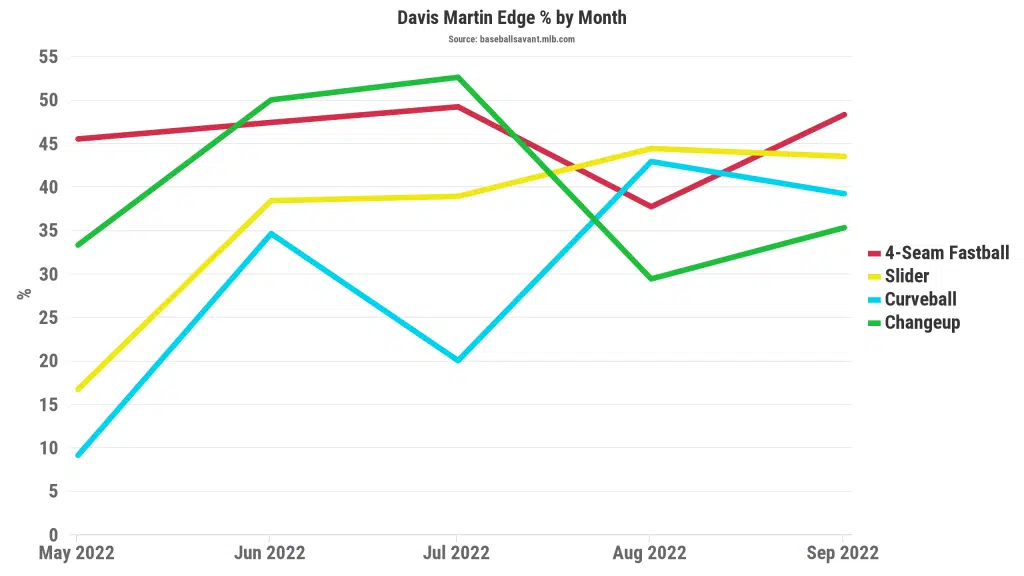
While at times we’ve seen Martin all over the map in terms of Edge%, September is the first month that all of Martin’s pitches really exhibit some sort of command (at least 35 Edge%) at the same time, and it’s produced some of his best results to date.

Why is this so important? Well, if you’re hitting the corners of the zone more often and hitters know this, at times, they’re going to chase pitches more often off the corners that they mentally process as strikes for about 50-55 feet before they drop out of the strike zone. If you leave more pitches in the center of the plate, when pitches start towards the corners, hitters will know those will likely drop out of the zone.
Indeed, we’ve seen some of the highest chase rates for Martin this past month for a few of his pitches. Take a look at Edge% and Chase% at the same time, and you’ll notice some correlation between the number of pitches a player is able to throw to the edges of the strike zone and the number of pitches they’ll be able to get hitters to chase as a result.
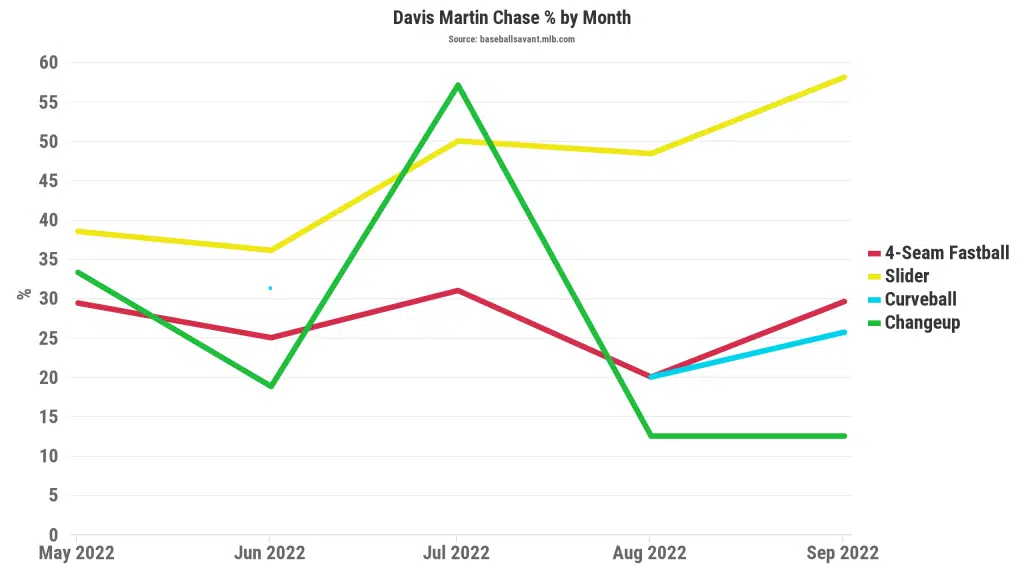
Obviously, some pitches are working better than others for Martin, which we will get to. However, if you’ve been looking closely at any of these graphics, there should be one pitch that’s been popping out to you the entire time…
Improvements to Slider
A quick look at the White Sox pitch value leaderboards might cause you to raise an eyebrow:


Besides the absolute hilarity that is Dylan Cease’s slider this season, Martin – despite a rather short season on the South Side comparatively – has the second-most valuable offspeed pitch on the White Sox and ninth-most valuable pitch on the entire staff. You can see just how effective this pitch has been throughout the article so far, as it’s posted the highest Whiff% (42.9%) and September Chase% (58.1%) of all of his pitches.
Given the near 40% chase rate on the slider coming in, Martin already came to the team with a pretty impressive slider. However, the most impressive part of Martin’s campaign with the club this season has been his ability to make in-season adjustments to make his slider even better.
Take a look at two sliders from May and September of this season:
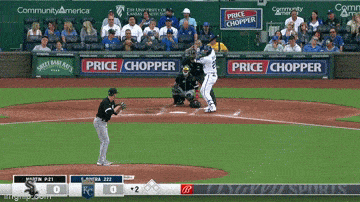
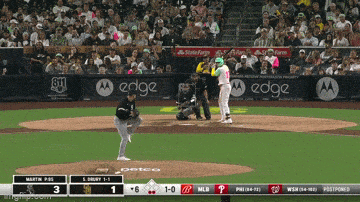
Earlier in the season, his slider looked a lot more like a curveball – it had a lot of vertical break (and still does). In fact, both he (38.1) and Dylan Cease (35.0) have very similar amounts of vertical break on their sliders. However, because of the speed at which Martin throws it, along with the movement of his curveball, it makes a lot more sense to have the pitch add some movement to it in the horizontal direction. He’s clearly done it, and by doing so, has seen Cease-like results on his slider throughout the season.
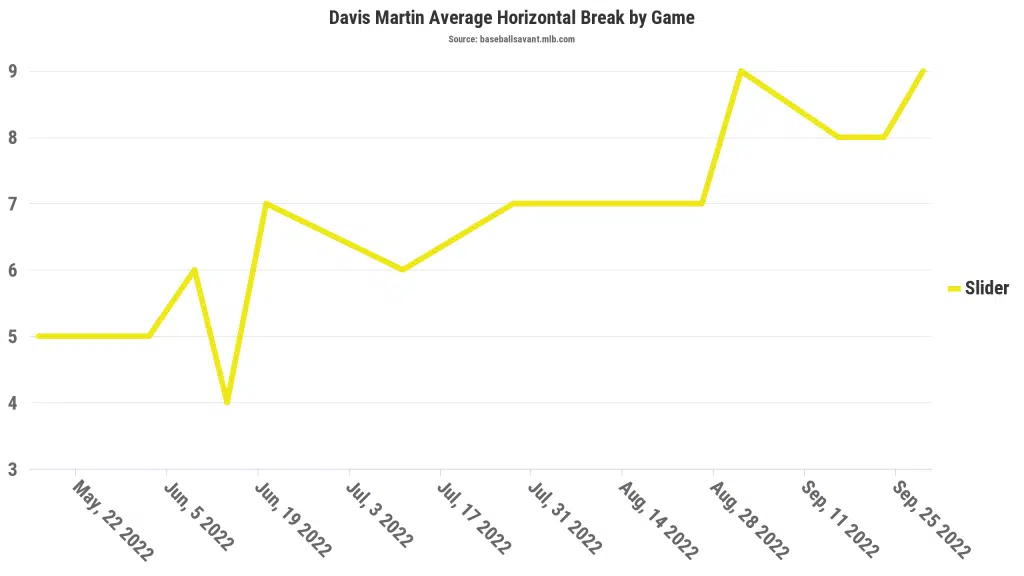
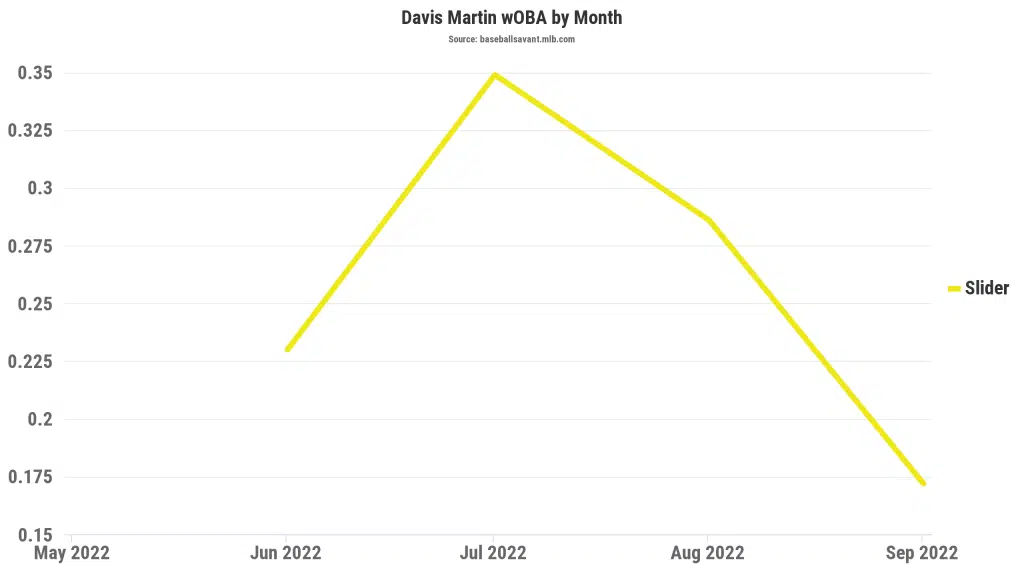
Compare the results on his slider to the ones that an AL Cy Young candidate has gotten on his slider:
| Pitcher | BA | xBA | SLG | xSLG | wOBA | xwOBA | Spin | Whiff % | Vert. Movement vs. Avg (in.) | Horiz. Movement vs. Avg (in.) |
|---|---|---|---|---|---|---|---|---|---|---|
| Martin | .177 | .175 | .253 | .224 | .221 | .210 | 2696 | 42.9 | 1.1 | 0.6 |
| Cease | .128 | .144 | .209 | .223 | .187 | .201 | 2833 | 43.3 | 1.7 | -0.3 |
The results haven’t always been there – that’s part of the maturation process for a pitcher. However, look at some of the similarities in the expected results for his slider. The results are remarkably similar in both xSLG and xwOBA for two pitchers at very different places in their careers.
Note that I’m not saying the sliders are the same or even on the course for being the same – Martin would have to start throwing his a lot harder before even beginning to explore the similarities in the pitches themselves. But, at the end of the day, when you have two starting pitchers who make in-season adjustments to their slider for the better, the natural place to turn is their pitching coach. For all intents and purposes, we can partially credit Ethan Katz for what has been Martin’s biggest in-season improvement that has led to increased success.
Next Steps for Continued Success
After reviewing some of the things that Martin has done well this season, where are some of the areas that he will need to improve in order to make himself part of the roster in 2023? Here are three key areas:
Added Fastball Spin/Life
Let’s take a look at Martin’s statistics on his fastball this season again:
| Pitch | BA | xBA | SLG | xSLG | wOBA | xwOBA | Spin | Whiff% |
|---|---|---|---|---|---|---|---|---|
| Fastball | .304 | .288 | .500 | .471 | .375 | .367 | 2357 | 12.8% |
At first glance, it’s a pretty average-to-above-average-spin pitch (79th percentile spin rate) that sees pretty below-average results. A 12.8 Whiff% on your fastball means hitters aren’t missing it nearly enough. The Active Spin on his fastball is 89%, so he’s getting a good amount of backspin on it, given what’s available. But, it’s not nearly enough to see long-term success at the major league level, especially when it’s a pitch that is thrown over 40% of the time.
If you take a look at the spin axis of how each of his pitches rotates, perhaps a minor change in release point could improve his ability to get more backspin on his fastball. At the same time, the pitch has a lot of spin (79th percentile spin rate), so it’s also about improving upon something that’s already there.

As of now, there’s no “proven” way to add backspin or just natural spin to a fastball – it’s all a trial and error process. But, given the spin axis of his fastball, it wouldn’t be a surprise to me if, in revisiting Davis Martin next season, he’s slightly changed his arm slot in hopes of giving more life to his fastball to increase swings and misses.
Solidifying third and fourth offerings
Now, let’s take a look at Martin’s other two pitches: his curveball and changeup.
| Pitch | BA | xBA | SLG | xSLG | wOBA | xwOBA | Spin | Whiff% |
|---|---|---|---|---|---|---|---|---|
| Changeup | .265 | .352 | .382 | .527 | .303 | .398 | 2188 | 16.9% |
| Curveball | .133 | .286 | .333 | .568 | .197 | .358 | 2629 | 21.1% |
While the whiff rates on both pitches are better than his fastball, they’re still not elite offerings by any means. However, given the movement each of these pitches has on them, it would greatly benefit Martin to begin to enhance what already exists for each of these pitches.

His changeup has above-average horizontal movement, so improving upon the command of this pitch could lead to it becoming a great offering breaking away from left-handed hitters. Additionally, his curveball has average-to-above average movement on it already, but continued work on its ability to become a put-away pitch (9.4% of the time) late in at-bats would keep hitters off of his slider in strikeout counts, or any count when Martin is ahead.
Dylan Cease gets away with three primary offerings because of how devastating his slider and curveball are. For Martin, while his stuff is good, in order to hit his ceiling, that fourth offering – which looks to be his changeup based on movement/results – becomes drastically more important. If he can come back into 2023 with a sharper curveball and improved feel for both his changeup and curveball, he will see drastically better results against hitters who may be keying on his fastball and slider.
Improve upon strikeout rate
This third section builds upon the first two. Martin has seen his strikeout rate go from 32.4% in AA to 28.3% in AAA to just 18.4% in the majors this season. At the very least, we know that Davis Martin can be a strikeout pitcher, which is why this section was ultimately included. That being said, in order for Martin to begin to strikeout hitters again at a 25% – 30% level, it’s going to require a bit of overhaul in everything he does.
It starts with concrete improvement on each of his pitches, as mentioned above. Entering 2023 with four pitches that are above-average in spin, movement, and command will make Martin’s stuff look even better than it is. From there, Martin and Ethan Katz will have to break down game-planning from a different perspective. Perhaps it involves a change in pitch mix that features his slider more than his fastball. Ask Dylan Cease about how well that can work for pitchers with excellent offspeed pitches and good-but-not-great fastballs. Alternatively, perhaps it involves more get-me-over curveballs early in the count, followed by great hooks in two-strike counts to keep hitters from sitting on sliders when Martin gets ahead in the count. In all reality, it’s probably a combination of everything we’ve discussed above. There are plenty of improvements to make to each of his pitches, as well as the command he features them with. Once he gets there, he can change up his pitch mix more effortlessly, and as a result, the strikeouts will come.
Why are strikeouts important? Well, when you see the difference between the expected statistics and actual statistics for Martin’s curveball and changeup, they feature an element of luck to them – balls hit right at infielders, fly balls that *just* stay in the ballpark, etc. When you’re able to decrease the number of balls put in play, you lessen the amount of potential damage hitters can do. At the same time, bringing those expected statistics down next season will also involve the element of improving his pitches.
Davis Martin is just scratching the surface of his major league career. As a result, any truly complete analysis of Martin likely requires at least a little bit more data than what is available to us right now. But, from what we’ve seen of Martin, we can tell that there have been legitimate changes both before the season and in-season to his mechanics and repertoire that should make the White Sox and their fans optimistic for growth and continued success in 2023. Additionally, Martin already features a slider that could be on the cusp of being elite, which puts him on the right track to repeat some of the success he’s seen this season. In order to get a repeat – and even improvement – of 2022, it doesn’t require incredibly drastic changes or a continuation of good luck. It simply involves a continual growth of Martin as a player and pitcher – an offseason of work with Ethan Katz certainly won’t hurt.
While the White Sox may be best served to have Martin play a long reliever role out of the bullpen to start the season, it likely wouldn’t be long before he is making starts himself. Look for the White Sox to find some sort of solution for their fifth starter, knowing in the back of their minds that Davis Martin is not too far away from making an impact.
It’s nice to get a player development win once in a while on the South Side. Martin is putting himself on a path to be just that.
Follow us @SoxOn35th for more!
Featured Image: Orlando Ramirez-USA TODAY Sports

Great article – never heard of edge %, that was interesting
My man. That was a true masterclass. My Dynasty Team and I thank you! Need to up my evaluation skills!